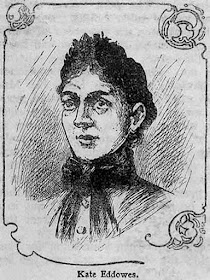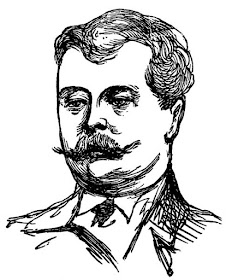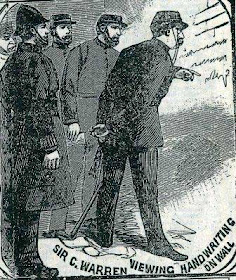I
was amazed to discover that London in 1888 - a city of 5.6 million
people - had only 63 recorded murders – including 9 abandoned
newborns and the 5 victims of Jack the Ripper. That is a rate of less
than 1 murder for every 200,000 people. In modern day London (2014)
there are more than 16 murders for every 200,000 people – about the
same number as New York City, but less than the 13 in Los Angeles or
the 23 murders per 200,000 residents of Houston or Dallas, Texas.
Of
course a lot of murders went unrecognized in 19th
century London. Was a death murder by poisoning or a result of
ingesting spoiled meat or polluted water? The police had no way of
telling, and coroners were not required to have a medical license
until well into the 20th
century. Suspicious deaths of professionals and the wealthy were
investigated.
But a worker on the London docks, a scullery maid, a
“hawker” who sold trinkets in the street, a porter at the
Spitafield Market or a middle aged prostitute, when these working
class were mugged on Whitechapel Road, garroted into unconscious,
knocked senseless outside a pub or left bleeding and robbed in a dark
alley, these crimes were rarely reported to either the police or the
newspapers. One researcher has discovered that according to official
records, no women in Whitechapel had their throats slashed during all
of 1886 or 1887. That contention seems so unlikely as to be absurd.
It
wasn't that the officials did not know what they were dealing with,
even if they could not give it a name. “The Spectator” had
speculated as early as the middle of September, “...the motive was
blood thirst,— that is, the crime itself was its own impelling
cause”. The magazine added that knowing the details of the victim's
life was “...of comparatively little use, for it usually helps only
to detect motive, and here the motive is...useless as an aid to
identification” But, The Spectator admitted, there were a few
things that were know about the killer. “He must...know that
district of Whitechapel well...And he is not a man to excite by his
mere appearance...or his victim would not have gone with him...Those
seem the only facts fairly clear, and they...scarcely help the
police, and they do not help the population at all...” But this
last time, the killer had left a new clue behind.
The
latest victim was Catherine Eddowes, a 46 year old cheerful
prostitute who was a loud and argumentative drunk, and had been in
police custody at the Bishopgate station until 1:00 a.m. that Sunday
morning. As she left the station house, her last words to the desk
sergeant were a cheery “Goodnight, old cock.” She was a ten
minute walk from Mitre Square. At 1:45 that Sunday morning she would
be found in the square, killed in the now classic Ripper fashion. She
had been first strangled from the front, and once unconscious or dead
was lowered to the ground where her throat was slashed. Then and only
then was she mutilated.
Her
inquest started on Thursday, 4 October, and Dr. Frederick Gordon
Brown, the City Police Surgeon described the condition of her body.
“She lay on her back. Head turned toward her left shoulder. Arms at
her side...Clothes were pushed above her abdomen, Thighs were
naked..Abdomen exposed. Bonnet at back of her head...
"Face
disfigured. Throat was cut. Intestines were drawn out and placed over
right shoulder. Another section of intestines were placed between
left arm and body. Clotted blood on pavement near left side of
neck...Fluid blood under neck and right shoulder.” Dr. Brown did
not share with the public that her vagina, her womb and part of one
kidney had been removed and taken away by the killer. But he did add,
“My attention was called to the apron - it was the corner of the
apron with a string attached...”.
City
of London Detective Sergeant Daniel Halse had also noticed the apron,
because “a piece of her apron was missing. About half of it. It had
been cut with a clean cut.” They were ubiquitous in Whitechapel, (Above, left) used by the working poor women to protect their dresses. Dr. Brown even had the opportunity to
compare the section found on the dead woman, with another piece of
white cloth found on Goulston Street, in Whitechapel. “I fitted the
piece of apron,” he told the inquest, “the seams of the borders
of the two actually corresponding - some blood and apparently fecal
matter was found on the portion found in Goulston Street"
Goulston
Street was a north south byway which connected the east west running
Wentworth to the Aldegate High Street. Like George Yard, it had
undergone a slum clearance project, with the worst slums on its
northern end cleared out and replaced in 1887 with the Brunswick
Buildings, new “model dwellings”.
And it was in the open
entryway of numbers 108 to 119 Brunswick Buildings on Goulston (above), near
the corner of Wentworth, that the majority of the white cloth apron
had been discovered just before 3:00 a.m. that Sunday morning by
Police Constable Alfred Long – 1 hour after Catherine Eddows was
discovered murdered, and no more than 1 hour 15 minutes after the
murder had been committed.
PC
Long had passed this same doorway at about 2:20 a.m. while walking
his beat, and he was positive the bloody cloth had not been there,
then. A
careful reading of all accounts makes it clear the apron was not far
inside the doorway, but in the open, visible to anyone. Other police officers, moving by prearranged plan to blanket
the area between the murder scene and Whitechapel, questioned all the
men they saw, and saw no one suspicious.
Specifically, Detective
Sergeant Halse had come down Goulston, passed the same doorway about 2:25 a.m. and also saw nothing and no one. So the killer had come this way sometime between 2:30 and 2:55 a.m. It reinforced the
belief that the killer had escaped Mitre Square - just over the border of the City of
London - by retreating into Whitechaple, where he felt safe. Where he
lived.
The
most direct route would have been to exit Mytre Square (above, lower left) next to the Great Synagogue, then turn south on Duke Street to Aldegate High Street,
turn right and walk past the Aldegate East Underground Station before
turning left, heading north up Goulston street to where the apron was found (above, red dot). That path was
the most public, the mostly heavily covered by police.
Or the killer
might have gone north on Duke Street, cut east to Houndsditch Street,
jogged south 1 block to Grave Lane, then
south to the short New Goulston Street, or jogged north to Turn Alley,
ending opposite 108-119 Goulston Street (above, blue circle). However he had jogged,
turned and hidden in the dark, he had remained unseen while the alarm
was raised all around him. Walked briskly he could have covered the
distance in about ten minutes. Moving carefully, Detective Halse had
done it in 20 minutes. And we know he beat the Ripper to the
Goulston Street because the bloody apron fragment was not there
when he passed the spot at about 2:15 a.m..
The
most logical explanation for taking the apron was to carry away his
trophies, the organs stolen from Catherine Eddowes. But the missing
organs were never found - overlooking the infamous kidney mailed to
George Akin Lusk (above), the 49 year old self-made Chairman of the
Whitechapel Vigilance Committee, which was probably just another
journalistic publicity stunt. The organs were in that entryway and
stairwell with the killer, sometime between 2:20 a.m. and 2:55 a.m. -
a 35 minute window.
And they left with the killer. Only the bloody
apron fragment remained behind. But how did he carry the organs
after he left this entryway? Did he live in the new buildings? Every
resident was questioned, all the apartments and buildings were
searched. It seemed clear the killer paused here, to transfer his
stolen goods to another container or bag. But where did he go from
here?
The
question was never fully asked because of what PC Long discovered
next. Scrawled on the door jam above the bloody apron was a message
written in chalk - “The Juwes are not the men that will be blamed
for nothing.’ What it meant was not and is not clear, other than being antisemitic and written by a non-native English speaker. And
different officers remember the wording differently.
They reacted to
the message differently, as well. Basically, the City of London
Police wanted the message left right were it was until it was light
enough to be photographed. The Metropolitan Police, in whose area this was, wanted it washed
away, at once.
In a couple of hours (it was not approaching 4:00
a.m.) Goulston Street would be filling with Jewish and Gentile
peddlers and Gentile and Jewish customers. When they heard about the
murder and saw the writing, a riot would be a real possibility. Except of course for other nasty writings scattered around Whitechaple.
The
issue was settled at about 5:15 a.m., when Sir Charles Warren, head
of the Metropolitan Police arrived on Goulston Street (above). He ordered the
writing to be washed away at once. And that was when all hell broke
loose, breaking right on top of Sir Charles' head.
- 30
-




























































